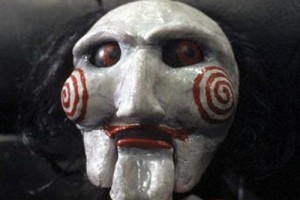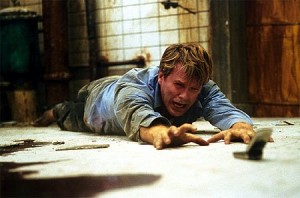 In 2004 my brother encouraged me to watch a horror movie that had come out which he thought I would enjoy. He was referring to Saw, but given the trailers I had seen for the film I wasn’t interested. It seemed like it was going to be just the latest in the trend in horror films for gratuitous gore and mayhem. Thankfully I was wrong in my assumptions about the film, as it presented a good story that takes place largely between two characters in a single room, a storytelling device forced on the screenplay writers by a limited budget, and which may have forced their creativity, resulting in a combination of crime drama and horror.
In 2004 my brother encouraged me to watch a horror movie that had come out which he thought I would enjoy. He was referring to Saw, but given the trailers I had seen for the film I wasn’t interested. It seemed like it was going to be just the latest in the trend in horror films for gratuitous gore and mayhem. Thankfully I was wrong in my assumptions about the film, as it presented a good story that takes place largely between two characters in a single room, a storytelling device forced on the screenplay writers by a limited budget, and which may have forced their creativity, resulting in a combination of crime drama and horror.
I agree with those film critics who interpret Saw as one that has much in common with the film Se7en with its focus on a religious and righteous serial killer, John Doe, who metes out justice on sinners, in this case those who violate or exemplify the Seven Deadly Sins of medieval Catholicism. Similarly, although Saw’s killer, Jigsaw, acts in a secular context with its very different motivations, the killer finds “sinners” who don’t appreciate the gift of life and who are placed in situations which mock their “sins,” their lack of appreciation for their life, and this way they are given a choice of pain and torture for redemption or they may suffer the effects of their sin resulting in death. Unfortunately, over time as the Saw franchise developed it quickly moved from this scenario to one of so-called torture-porn and the glorification of bodily mutilation. With this trajectory much of the moral undertone of the first film is gone, or at least fades into the background.
 I recently became aware of another interpretive possibility for the Saw films, at least the first two films in the franchise, in an article by Dana Fore in GOLEM Journal. Fore presents an alternative reading for the films as “registers of cultural trauma in the post-9/11 world.” As Fore writes,
I recently became aware of another interpretive possibility for the Saw films, at least the first two films in the franchise, in an article by Dana Fore in GOLEM Journal. Fore presents an alternative reading for the films as “registers of cultural trauma in the post-9/11 world.” As Fore writes,
What is most unsettling (but also potentially cathartic) about these films is their acknowledgment of anxieties related to “unreadability”‘ — fears intensified in a wartime culture by euphemistic, mass media rhetoric that hides or reinterprets the realities of violence.
In my view this alternative reading is entirely possible, although I have minor disagreements with aspects of Fore’s overall proposal. I do not find as much value in Freudian interpretive elements as Fore does. I would also take exception to his characterization of ancient laws of sacrifice and sacred violence as necessarily “superstitious.” This term is at times used by modern thinkers to argue that we are more enlightened than the ancients who allegedly didn’t know better. The ancients weren’t as foolish as we often think, and a dose of humility may be in order here. In the future will our successors likewise brand some of our ideas as superstitious? The term is somewhat relative to one’s culture and present state of knowledge, privileging on way of knowing over another, and how does one know that one’s own conceptions are undoubtedly rational and correct while those in the past are superstitious?
At any rate, I present Fore’s article for consideration for those interested in alternative readings for the first two films in the Saw franchise that may deepen our understanding of the cultural anxieties it presents in our current penchant for torture and mutilation in horror.





One Response to “SAW: Cultural Registers for Post-9/11 Anxiety?”